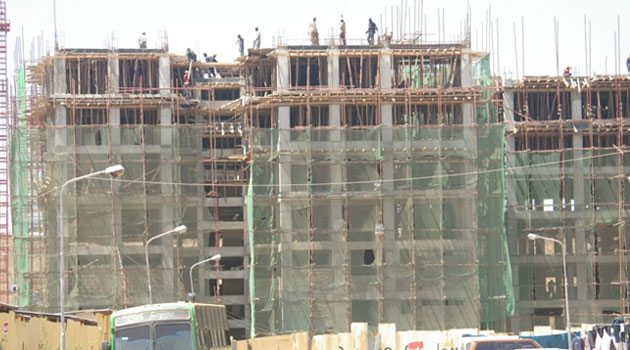
The private sector has constructed 15,000 units per year, focussing on upper-middle-class income at 48 percent and high income at 35 percent with only 2 percent segmented for the lower income. Photo/XINHUA
NAIROBI, Kenya, Apr 12 – If you are not in the upper middle class or the wealthy, chances of owning a home in Kenya remain slim to never.
According to a World Bank report, a majority of Kenyans have no access to affordable mortgage, and the available pricey mortgages chase few upmarket units.
For starters, the government has failed to increase the formal affordable houses in the country.
Kenya’s first medium-term plan for 2009 to 2012 in the vision 2030 strategy had an initial target of providing 200,000 housing units annually for all income levels but only delivered 3, 000 units, same case for the medium term two between 2013 to 2017.
The private sector, on the other hand, has constructed 15, 000 units per year, focussing on upper-middle-class income at 48 percent and high income at 35 percent with only 2 percent segmented for the lower income.
So who will take care of the millions of Kenyans who are not rich enough? What is holding back affordable housing?
“A key constraint for low and middle-income buyers comes down to a limited supply of financing, currently mortgage lending is funded almost entirely by short-term retail and institutional deposits and only a few financial institutions have accessed the capital markets,” said the WB reported, dubbed, Housing Unavailable and Unaffordable.
According to the report, 10 percent of all housing credit comes in the form of mortgages from the banking sector with the remainder sourced from Savings and Credit Co- operatives (SACCOs) and housing cooperative networks.
Kenya’s mortgages have continued to stagnate at about 25,000 in a country with more than 41 million people despite the country being among the fastest growing economies in the continent.
The mortgages have an average amount of Sh8 million.
Mortgage debt is currently at 3.15 percent of Kenya’s Gross Domestic Product (GDP) as at December 2015. Comparatively, South Africa’s mortgage debt stands at 33 percent of the GDP, with interest rates averaging 10.5 percent.
“The constraints for banks are mainly in terms of risk-return decisions, but housing finance is also considered to be relatively unattractive compared with investment in T-bills. The administrative burden of complex land transfer and mortgage registration is a further disincentive to increase the amount of mortgage finance.”
“Moreover, reaching downmarket requires assessing the credit risk of informal sector borrowers, which is problematic,” the report notes, adding that a majority of informal sector borrowers are more interested in incremental financing and self-construction loans.
SACCOs helping, but limited
“The main providers of housing finance for this sector are the cooperative networks or the SACCOs,” the report explains.
Kenya’s SACCOs are the ‘to-go-to’ for formal mortgage loans through the KUSCCO Housing Fund and provide large amounts of loans used for self-construction.
SACCO and cooperative sector are providing over 100,000 housing loans, with 10 percent being actual registered mortgages. The sector also provides these loans at more affordable rates, rarely exceeding 14 percent interest per annum.
Typical loans can extend to up to seven years.
Loans are typically unsecured or at least not secured with a mortgage lien over a property.
Despite limits on the amount and the shorter term, this type of credit is more easily accessible and is provided at a cheaper rate than many of the traditional banks can offer.
SACCOs may either purchase land or resell to members with some financing support for self- building or act as a full developer, with projects ranging from 10 houses to several hundred.
However, despite their affordability, they have been unable to fully cater for the sector,
“On one hand, it was found that housing cooperatives provide a good range of housing options with prices varying from as low as Sh600,000 up to Sh14 million. Location is a big factor in terms of determining the overall housing cost and the cost of infrastructure is a major determinant in the type of housing that is built. The cooperative housing provider has to break even and often the only way is to also build upper-end housing where a larger premium can be charged,” the report elaborates.
Moreover, even as they try to fill the gap, they are held back by the lack of finance due to the fact that their main source of liquidity is member deposits with limited access to longer-term sources of finance.
Difficulties or delays in obtaining clean titles has also been a contributing factor to the limited mortgages as it leads to a decrease in investor appetite and also prevents households from securing finance from banks.
“Speculative behaviors have triggered rapid price increases since 2009, and the absence of tools to limit their impact has made this a major problem for land markets. There is also the limited supply of serviced land – an insufficient capacity to develop infrastructure in parallel with urban expansion and land allocation or conversion.”
“The responsibility for providing this infrastructure is then transferred to developers who in turn pass the related cost on to buyers through higher prices. Reliance on private developers to provide infrastructure results in inefficient and more costly solutions,” the report underscores.
The report says that Kenya needs two million more low-income homes
According to Mehnaz Safavian, Lead Financial Sector Specialist and co-author of the report, “Kenya can make housing more affordable to many more Kenyans, and in turn create new channels to boost overall economic growth both at the national and county levels.”


































